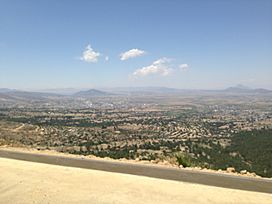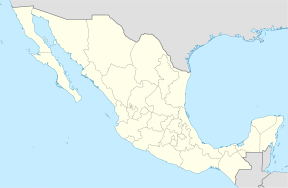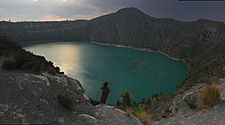Oriental Basin facts for kids
Quick facts for kids Oriental Basin |
|
|---|---|

Valley of Libres
|
|
| Floor elevation | 2,360 m (7,740 ft) |
| Geography | |
| Rivers | Río Salado |
The Oriental Basin is a special kind of valley in east-central Mexico. It is also known by other names like the Libres-Oriental Basin or the San Juan Plains. This basin is unique because it is an endorheic basin, meaning its water does not flow out to the ocean. Instead, all the water stays within the basin.
This large area covers about 4,958 square kilometers. It stretches across three Mexican states: Puebla, Tlaxcala, and Veracruz.
The weather in the Oriental Basin is usually mild. It can be semi-dry to somewhat humid, with most of the rain falling in the summer. The average temperature is between 12 and 16 degrees Celsius each year. The basin gets about 400 to 800 millimeters of rain annually.
Tall mountains surround the basin on its west, north, and east sides. These mountains are covered with Trans-Mexican Volcanic Belt pine-oak forests. The mountains, especially the Cofre de Perote volcano, create a "rain shadow" effect. This means they block rain from reaching the valley. Because of this, the center of the basin is quite dry. It has dry shrublands similar to the Tehuacán Valley.
You can find different types of plants here. Higher up in the mountains, there are pine and oak forests. In the drier parts of the basin, you'll see dry scrub pine forests, oak forests, and areas with juniper and yucca plants. There are also special plants that like salty soil, and open grasslands.
The basin has several shallow lakes, most of which are salty. Two of these lakes, Totolcinco and Tepeyahualco, are "playa lakes." This means they are usually dry for most of the year. They are located in the lowest part of the basin, about 2300 meters above sea level.
The basin also has six special lakes called maar lakes, or axalpazcos. These lakes formed in shallow volcanic craters and are fed by underground water. Four of these lakes – Alchichica, Quechulac, Atexcac, and La Preciosa – are in the northern part of the basin. The other two, Aljojuca and San Miguel Tecuitlapa, are in the southern part. There are also five dry maars in the area.
Some of the main towns in the Oriental Basin include El Carmen Tequexquitla, Tlaxcala; Perote, Veracruz; and Oriental, Puebla.
Sadly, the amount of underground water in the basin has been decreasing. This is because too much water is being used for farming. Also, natural areas that help refill the underground water are being destroyed. There are even plans to pump fresh water from the Oriental Basin to big cities like Mexico City and Puebla.
Maar Lakes: Unique Water Bodies
The maar lakes, also known as axalpazcos, in the Oriental Basin are very special. Each of these crater lakes is home to unique animal species that are found nowhere else in the world. These animals have adapted to live in these specific lakes.
For example, some fish species called silversides live only in these lakes. These include the Alchichica silverside (Poblana alchichica), La Preciosa silverside (P. letholepis), Chignahuapan silverside (P. ferdebueni), and Quechulac silverside (P. squamata). Sadly, three types of dace fish that used to live in the basin are now believed to be extinct since around 1970.
Scientists group the Oriental Basin's freshwater areas with other regions like the Valley of Mexico and Lake Chapala. They do this because many of the fish species, especially the silversides, are similar across these areas.
| Lake | Surface Area (square kilometers) | Volume (millions of cubic meters) | Maximum Depth (meters) |
|---|---|---|---|
| Alchichica | 1.81 | 69.9 | 64.6 |
| La Preciosa | 0.78 | 16.2 | 45.5 |
| Quechulac | 0.50 | 10.9 | 40.0 |
| Aljojuca | 0.44 | 11.6 | 50.6 |
| Atexcac | 0.29 | 6.1 | 39.1 |
| Tecuitlapa | 0.26 | 0.35 | 2.5 |
Lake Alchichica: A Deep and Salty Home
Lake Alchichica (19°25′N 97°24′W / 19.417°N 97.400°W) is located in Tepeyahualco (municipality), Puebla. It is the biggest of the maar lakes in the Oriental Basin. This lake sits at an elevation of 2320 meters above sea level.
It is Mexico's deepest natural lake, reaching a maximum depth of 64 meters. The lake covers an area of 1.81 square kilometers. Its water is both salty and alkaline, meaning it has a high pH level (between 8.7 and 9.2).
Lake Alchichica is very special for its environment. It has unique rock formations called stromatolites, which are built by tiny living things. Many species found here are endemic, meaning they live only in this lake. The plants and animals in Lake Alchichica have adapted to its extreme conditions, like the high salt content and low nutrients.
The lake is home to various tiny organisms like bacteria and algae. Many different types of phytoplankton, which are tiny plants that float in the water, have been found here. Larger plants that grow in the water include reeds, rushes, and pondweeds.
Animals that live only in Lake Alchichica include the Taylor's Salamander (Ambystoma taylori). There's also a unique fish called the Alchichica silverside (Poblana alchichica), and a small crustacean called the isopod (Caecidotea williamsi).
See also
 In Spanish: Llanos de San Juan para niños
In Spanish: Llanos de San Juan para niños



